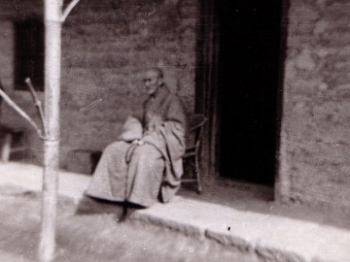 At the cowshed. True Suchness Chan Monastery, Jiangxi Province, 1959. From Eric Johns
At the cowshed. True Suchness Chan Monastery, Jiangxi Province, 1959. From Eric Johns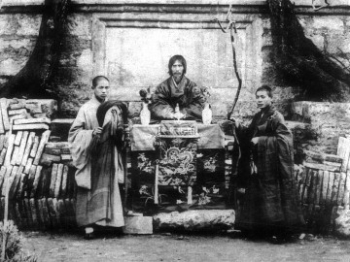 At Cloud Perch Monastery, Yunnan Province, 1926. From Eric Johns
At Cloud Perch Monastery, Yunnan Province, 1926. From Eric Johns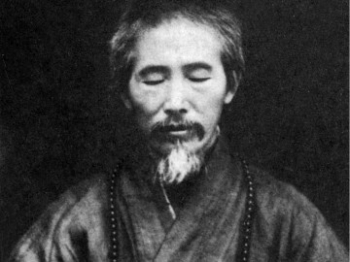 At Southern Flower Monastery, Guangdong Province, 1935. From Eric Johns
At Southern Flower Monastery, Guangdong Province, 1935. From Eric Johns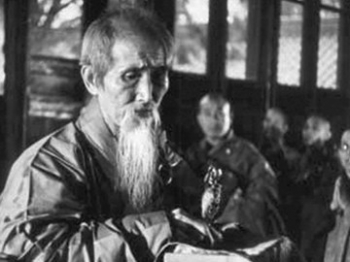 In Beijing, 1953. From Eric Johns
In Beijing, 1953. From Eric Johns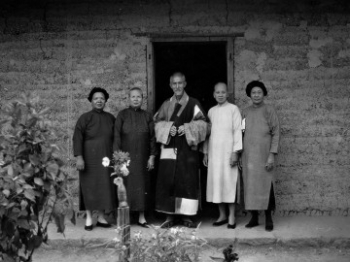 At True Suchness Chan Monastery, Jiangxi Province, 1955. From Eric Johns
At True Suchness Chan Monastery, Jiangxi Province, 1955. From Eric JohnsMaster Empty Cloud, or Xu Yun (虚雲), was born in Fujian Province in southern China during the Qing dynasty (1644–1911), on 26 August 1840. This was the time of the first Opium War, when Hong Kong was ceded to the British Government. His father was from the privileged Xiao (蕭) family, who were descendants of the Buddhist emperor Wu of Liang (r. 502–49). The Master was born in his caul, or skin bag (amniotic sac), and while the next day a barefoot doctor came and cut him out, his mother died as a result of the birth. Xu Yun received a Daoist education but had a strong urge to follow Buddhism, and so at the age of 17 ran away from home to become a monk. He was soon caught, however, and taken home, where his family forced him to remain. He was also obliged to marry two teenage girls in order to continue the family line. The Master had a platonic relationship with the girls, and taught them the Buddha-Dharma. They were later ordained as nuns, along with his stepmother, who had raised him.
Unhappy with this secular life, when he was 19 Xu Yun ran away again and soon became a novice monk at Bubbling Spring Chan Monastery (湧泉禅寺) on Drum Mountain (鼓山) in Fujian. The next year he was fully ordained, and was given the Dharma names De Qing (德清; Virtuous Clarity), Gu Yan (古巖; Ancient Rock), and Yan Che (演徹; Develop Thoroughly). Afterwards, he lived and practiced alone in a cave near the monastery, hiding out as he did not want his father’s scouts to find him again. When his father died three years later he returned to the monastery, where he lived for the next three years. Feeling that monastery life was not helping his practice to develop, however, he left to wander around freely and openly, living a hippy-style life as a poetry-writing, enlightened young sage, eating wild herbs and drinking spring water. Then, one day, he came across a Buddhist teacher in a thatched temple on Tiantai Mountain. This is where he first learned about Chan meditation, and his spiritual practice quickly and significantly improved.
When he had been a monk for more than 20 years, Master Empty Cloud decided to go on a “three steps, one bow” style of pilgrimage, partly to repay the debt to his parents. He started off from the island Putuo Shan near the city of Ningbo and went all the way to the mountain Wutai Shan, near the city of Datong in northern China. Reciting the name of the bodhisattva Manjushri with each prostration as he went, it took him three long years. After that, he walked across China and into Tibet, where he wept at the sight of monks eating meat. He then went on pilgrimage to India and Burma, before returning to China in 1890.
In 1895, aged 56, Xu Yun attended a 12-week meditation retreat at High Heaven Monastery (高旻寺) near Yangzhou on the Yangzi River. One evening during the eighth week, a tea server missed the teacup the Master was holding out and spilled hot tea on his hand. He dropped the cup, and as it broke, the sound caused him to have a deep spiritual experience, or awakening, after which he wrote an “enlightenment poem”:
Cup smashed on the ground,
Sound splinters resplendent,
Space also smashed,
Crazy mind suddenly stopped.
(Empty Cloud)
In 1900, following the Boxer Uprising, the Master fled Beijing with the imperial family, some of whom he had previously met in the monasteries where he had taught. Along the way, they witnessed the dire poverty and food shortages that were affecting the country, and soon after reaching Reclining Dragon Monastery (卧龍寺) in Xi’an, he assisted in Buddhist ceremonies to pray for snow and rain to end the terrible drought and famine. Feeling that there was too much activity at the monastery, however, he left one night in secret and climbed the nearby Zhongnan Mountains, which are inhabited by both Daoist and Buddhist hermits to this day. High up in the clouds he found a secluded spot, where he built a hut from stone and thatch and called it the “Lion Hut.” There he grew potatoes, chanted the Diamond Sutra, and meditated. It was at that time that he changed his name to Empty Cloud so that nobody would know he was there. He did not want to be disturbed by people coming to see him.
One day, a couple of years later, while still in the mountain hermitage, he put some potatoes on to boil and sat down in meditation to wait for them to cook. When some other hermits who lived nearby came to wish him a Happy New Year and to find out why they had not seen him around, they saw tiger’s paw prints in the snow outside his hut. Finding him deeply absorbed in meditation, they roused him. “The potatoes should be cooked by now, so please eat,” he offered, unaware that any significant length of time had passed. In fact he had been sitting there in deep samadhi for ten days, and the potatoes were covered with over an inch of mold! The hermits laughed, and then melted some ice to cook some more. A lot of people came to see Xu Yun after that, so one night he took off and left again, with just a few provisions slung on his back.
In 1906, Xu Yun returned to Beijing, where the Guangxu emperor (r. 1871–1908) issued a decree instructing that he was to be overall abbot of the monasteries on Chicken Foot Mountain (雞足山) in Yunnan Province, in China’s southwest. He was given the title “Grand Master Buddha’s Compassion and Vast Dharma,” (佛悲洪法大师) and also a copy of the entire Buddhist canon and a purple kashaya (robe), together with a sedan chair. He thus returned to Chicken Foot Mountain, which he had visited on his return from India, at which time he had vowed to re-establish Buddhism there. He soon began to raise funds in neighboring countries to restore the monasteries on the mountain to their former glory and to build a hall to house the canon. This included going to Thailand, where, at one point, he sat in samadhi for over a week, when no one dared to disturb him. Partly because of this, the king became his personal student.
The Master was later invited back to Drum Mountain in Fujian Province, where he had been ordained, and in 1930 officiated as abbot there. While there he restored Bubbling Spring Chan Monastery. In 1934, he moved to the large monastery of the Sixth Chan Patriarch in Guangdong Province, known as Southern Flower Monastery (南花寺), and restored that one as well, and completely rebuilt the nearby Cloud Gate Chan Monastery (雲門禅寺). The money came in part from Hong Kong, which he visited a couple of times specifically in order to raise funds. However, in the spring of 1951, when Xu Yun was around 112, thugs looking for gold and money attacked Cloud Gate monastery, breaking the Master’s nose and ribs and torturing and beating him almost to death. When the government in Beijing found out, they sent officials to the monastery to investigate. There, they found the Master and around 100 monks held in captivity. It was at this time that the Master began dictating his life story—he had been so close to death that the monks had asked him to tell it, fearing that it would be lost forever.
In 1952, Master Xu Yun went to Beijing to help found the Buddhist Association of China, which was set up by various Buddhist groups to try and protect Buddhism under the communist regime. He later undertook the rebuilding of True Suchness Chan Monastery (真如禅寺), near the city of Nanchang in Jiangxi Province, which had been destroyed during the Japanese occupation. This was the last Buddhist monastery built before the Cultural Revolution (1966–76). Money poured in from Shanghai, Hong Kong, and Canada, and it was therefore completed very quickly.
When he died one chilly October night in 1959, alone on his simple plank bed, the Master had been alive for 119 years and a monk for roughly 100. His last home was a converted thatched adobe cowshed that he liked. Xu Yun was the Dharma heir to all five Chan schools in China. During his life, he led many Chan meditation retreats at which people experienced awakening; he taught Pure Land Buddhism and lectured on the sutras; and he restored six great Chan monasteries and many smaller temples. He injected new life into the Chan school, which had been in real danger of being lost in China. His example inspired the present generation of Chinese Buddhists, who came to know him through his direct students. Some of them taught Chan internationally, as was his wish, and some remained in China throughout the Cultural Revolution.
Master Empty Cloud’s legacy lives on today. There are now shrines with statues of him across China as well as regular Chan retreats in his style held in large Chan training monasteries. Last year saw an exhibition of photos in Shanghai attended by his personal attendant, Master Shao Yun. There have been TV documentaries about him, and recently, a film was made of his entire life story. For full details of these, visit Empty Cloud. 


















